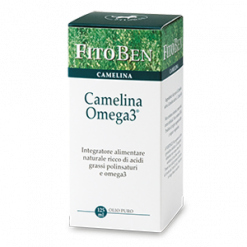Camelina Omega3 ®
€15,00
Lipid metabolism (triglycerides)
Camelina Omega3 ® is a natural remedy for the lipid metabolism (triglycerides). It is a tonic and a support for the organism.
A natural supplement made of pure Camelina sativa oil, cold pressed without solvents, it is naturally rich in polyunsaturated fatty acids and Omega 3. Naturally contains Vitamin E.
FREE SHIPPING with 39 € shopping
And if you reach 100 euros of spending, you have an additional 10% discount
18 in stock
Camelina Omega3 – Lipid metabolism (triglycerides)
Camelina Omega3™ is a natural remedy for the lipid metabolism (triglycerides). It is a tonic and a support for the organism.
A natural supplement made of pure Camelina sativa oil, cold pressed without solvents, it is naturally rich in polyunsaturated fatty acids and Omega 3.
– it improves lipid metabolism (triglycerides)
– it contributes to the maintenance of normal cholesterol levels.
– it contrasts the skin dryness.
– it contrasts mucous membrane dryness.
– it has a tonic and a supportive action.
– it contrasts fatigue and tiredness.
– it acts as anti-inflammatory for joints.
Camelina sativa is an oilseed known since the bronze age, that is a member of the Brassicacee family, like Colza, Mustard and Turnip. It is also called false Flax or wild Flax because of its similarity to Flax oil.
From harvest, an oily seed is obtained, from which come an oil rich in Omega 3, Omega 6 and other polyunsaturated fatty acids. It has a perfect balance between Omega-3 and Omega-6 (2:1 ratio). It is also an excellent source of Vitamin E, known fot its anti-oxidant properties.
Camelina’s crop has a very low environmental impact thanks to its adaptability to low temperatures and semi-arid climates. It could be cultivated also in marginal areas. It is a very strong plant that can resist to several disease, parasites and insects; for this reason, it doesn’t need plant protection products or herbicides.
For these reasons Camelina’s crop is useful to development in poor countries and areas and doesn’t create pollution or over-exploitation of the soil.
Bibliography:
1. Nì Eidhin D, Burke J, O’Beirne D (2003). Oxidative stability of ω3-rich Camelina oil and Camelina oil-based spread compared with plant and fish oils and sunflower spread. Journal of food science, vol. 68, nr. 1, pp; 345-353.
2. Karvonen M H, Aro A, Tapola S N, Salminen I, Uusitupa M I J, Sarkkinen E S ( 2002). Effect of α-Linolenic acid-rich Camelina sativa oil on serum fatty acid composition and serum lipids in hypercholesterolemic subjects. Metabolism, vol. 51, nr. 10; pp. 1253-1260.
3. Ren J, Chung S H ( 2007). Anti-inflammatory effect of α-Linolenic acid and its mode of action through the inhibition of nitric oxide production and inducible nitric oxide synthase gene expression via NF-κB and mitogen-activated protein kinase pathways. J. Agric. Food Chem., vol. 55, nr. 13; pp. 5073-5080.
4. Mozaffarian D (2005). Does alpha-linolenic acid intake reduce the risk of coronary heart disease? A review of the evidence. Alternative therapies, vol. 11, nr. 3; pp. 24-30
| Weight | 1,0000 kg |
|---|---|
| Plants and main active ingredients | Camelina sativa oil – To know more about the plant visit http://www.camelina.it |
| Therapeutic associations | Clafos, Aglio composto, Monascus più. |
| Composition | Pure Camelina sativa oil (Camelina sativa L.Crantz oil) Cold pressed oil without solvents NUTRITION TABLE 99% fatty acid. Average values of the main fatty acids per recommended daily dose (6g): α-linolenic acid ALA (ω 3) C 18:3 = 2,1 g Linoleic acid (ω 6) C 18:2 = 1,2 g Eicosanoic acid C 20:1= 0,75 g Oleic acid C 18:0 = 0,96 g Palmitic acid C 16:0 = 0,36 g Vitamin E = 6,9 mg (57,5% NRV*) NRV*: nutrient reference values. Without additives, artificial coloring or artificial flavoring and GMO. Vegetal origin product suitable for vegans and vegetarians. |
| How to use | Take 6.5 ml per day (measuring spoon or 3 teaspoons) corresponding to 6g of oil for breakfast. |
| Quantity | 125 ml |
| EAN code | 8032755371083 |
| PARAF code | 972472017 |
| Ministerial code | 91395 |
| Warnings | Do not exceed the indicated daily dose. Keep out of reach of children under three years. Store in a cool, dry place. Dietary supplements are not intended as a substitute for a varied diet |
Show reviews in all languages (8)







Reviews
There are no reviews yet.